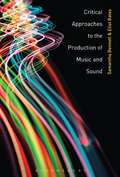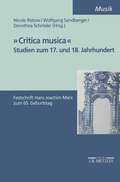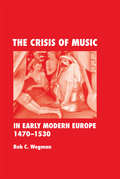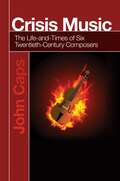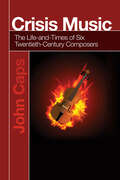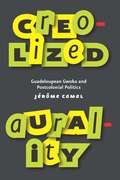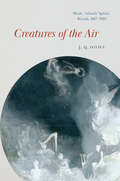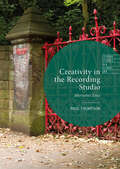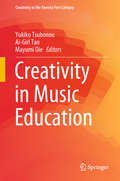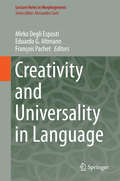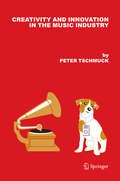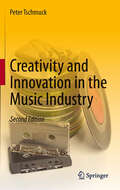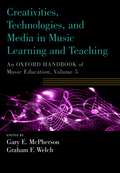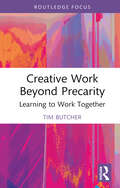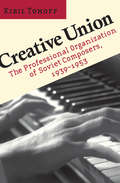- Table View
- List View
Critical Approaches to the Production of Music and Sound
by Samantha Bennett Eliot BatesWho produces sound and music? And in what spaces, localities and contexts? As the production of sound and music in the 21st Century converges with multimedia, these questions are critically addressed in this new edited collection by Samantha Bennett and Eliot Bates. Critical Approaches to the Production of Music and Sound features 16 brand new articles by leading thinkers from the fields of music, audio engineering, anthropology and media. Innovative and timely, this collection represents scholars from around the world, revisiting established themes such as record production and the construction of genre with new perspectives, as well as exploring issues in cultural and virtual production.
Critical Approaches to the Production of Music and Sound
by Samantha Bennett Eliot BatesWho produces sound and music? And in what spaces, localities and contexts? As the production of sound and music in the 21st Century converges with multimedia, these questions are critically addressed in this new edited collection by Samantha Bennett and Eliot Bates. Critical Approaches to the Production of Music and Sound features 16 brand new articles by leading thinkers from the fields of music, audio engineering, anthropology and media. Innovative and timely, this collection represents scholars from around the world, revisiting established themes such as record production and the construction of genre with new perspectives, as well as exploring issues in cultural and virtual production.
"Critica Musica" - Studien zum 17. und 18. Jahrhundert: Festschrift Hans Joachim Marx zum 65. Geburtstag
Die Beförderung der historisch-kritischen Musikwissenschaft ist das Anliegen der vorliegenden Festschrift.
The Crisis of Music in Early Modern Europe, 1470-1530
by Rob C. WegmanIn the final decades of the fifteenth-century, the European musical world was shaken to its foundations by the onset of a veritable culture war on the art of polyphony. Now in paperback, The Crisis of Music in Early Modern Europe tells the story of this cultural upheaval, drawing on a wide range of little-known texts and documents, and weaving them together in a narrative that takes the reader on an eventful musical journey through early-modern Europe.
The Crisis of Music in Early Modern Europe, 1470-1530
by Rob C. WegmanIn the final decades of the fifteenth-century, the European musical world was shaken to its foundations by the onset of a veritable culture war on the art of polyphony. Now in paperback, The Crisis of Music in Early Modern Europe tells the story of this cultural upheaval, drawing on a wide range of little-known texts and documents, and weaving them together in a narrative that takes the reader on an eventful musical journey through early-modern Europe.
Crisis Music: The Life-and-Times of Six Twentieth-Century Composers
by John CapsStory-like chapters profile six twentieth-century reactive composers; not the most famous pillars of the period but lesser-known, perhaps more approachable, characters whose stories span that 1900-2000 period from decadent fin-de-siècle Vienna (Alban Berg, Alexander Zemlinsky) to war-torn Paris (Olivier Messiaen, Arthur Honegger) to the Cold War tensions of East vs. West (Tōru Takemitsu) and late-century Communism (Arvo Pärt). Their stories were all very different crises, and they produced very different kinds of music; each very telling of their composers life and times. Crisis Music presents each brief biography almost like a detective story looking for motives, then spotlights one particular piece of music from each composer that emerged directly out of hard times maybe a political crisis at the time of composition (Hitler marching into Paris or later Communist crack-downs); or some personal angst such as illness or scandal and how that music contains and expresses crisis. In short, the subject for discussion is how context influences content. Such troubled and especially vivid composition, crisis music, can often be most compelling and meaningful for its composer and for its time. Indeed, their music also seems to have a special resonance to share with our own crisis-prone times. And meanwhile, Western music history played-out its own story from late-romantic style to Serialism and Minimalism to the anything-goes Pluralism we hear today. Crisis Music sparks the discussion about how history, biography and music intersects. At the behest of music teachers at secondary and tertiary levels, Crisis Music contains substantive Discussion Questions geared for classroom use.
Crisis Music: The Life-and-Times of Six Twentieth-Century Composers
by John CapsStory-like chapters profile six twentieth-century reactive composers; not the most famous pillars of the period but lesser-known, perhaps more approachable, characters whose stories span that 1900-2000 period from decadent fin-de-siècle Vienna (Alban Berg, Alexander Zemlinsky) to war-torn Paris (Olivier Messiaen, Arthur Honegger) to the Cold War tensions of East vs. West (Tōru Takemitsu) and late-century Communism (Arvo Pärt). Their stories were all very different crises, and they produced very different kinds of music; each very telling of their composers life and times. Crisis Music presents each brief biography almost like a detective story looking for motives, then spotlights one particular piece of music from each composer that emerged directly out of hard times maybe a political crisis at the time of composition (Hitler marching into Paris or later Communist crack-downs); or some personal angst such as illness or scandal and how that music contains and expresses crisis. In short, the subject for discussion is how context influences content. Such troubled and especially vivid composition, crisis music, can often be most compelling and meaningful for its composer and for its time. Indeed, their music also seems to have a special resonance to share with our own crisis-prone times. And meanwhile, Western music history played-out its own story from late-romantic style to Serialism and Minimalism to the anything-goes Pluralism we hear today. Crisis Music sparks the discussion about how history, biography and music intersects. At the behest of music teachers at secondary and tertiary levels, Crisis Music contains substantive Discussion Questions geared for classroom use.
Creolized Aurality: Guadeloupean Gwoka and Postcolonial Politics (Chicago Studies in Ethnomusicology)
by Jérôme CamalIn the Caribbean island of Guadeloupe, the complex interplay between anticolonial resistance and accommodation resounds in its music. Guadeloupean gwoka music—a secular, drum-based tradition—captures the entangled histories of French colonization, movements against it, and the uneasy process of the island’s decolonization as an overseas territory of France. In Creolized Aurality, Jérôme Camal demonstrates that musical sounds and practices express the multiple—and often seemingly contradictory—cultural belongings and political longings that characterize postcoloniality. While gwoka has been associated with anti-colonial activism since the 1960s, in more recent years it has provided a platform for a cohort of younger musicians to express pan-Caribbean and diasporic solidarities. This generation of musicians even worked through the French state to gain UNESCO heritage status for their art. These gwoka practices, Camal argues, are “creolized auralities”—expressions of a culture both of and against French coloniality and postcoloniality.
Creolized Aurality: Guadeloupean Gwoka and Postcolonial Politics (Chicago Studies in Ethnomusicology)
by Jérôme CamalIn the Caribbean island of Guadeloupe, the complex interplay between anticolonial resistance and accommodation resounds in its music. Guadeloupean gwoka music—a secular, drum-based tradition—captures the entangled histories of French colonization, movements against it, and the uneasy process of the island’s decolonization as an overseas territory of France. In Creolized Aurality, Jérôme Camal demonstrates that musical sounds and practices express the multiple—and often seemingly contradictory—cultural belongings and political longings that characterize postcoloniality. While gwoka has been associated with anti-colonial activism since the 1960s, in more recent years it has provided a platform for a cohort of younger musicians to express pan-Caribbean and diasporic solidarities. This generation of musicians even worked through the French state to gain UNESCO heritage status for their art. These gwoka practices, Camal argues, are “creolized auralities”—expressions of a culture both of and against French coloniality and postcoloniality.
Creolized Aurality: Guadeloupean Gwoka and Postcolonial Politics (Chicago Studies in Ethnomusicology)
by Jérôme CamalIn the Caribbean island of Guadeloupe, the complex interplay between anticolonial resistance and accommodation resounds in its music. Guadeloupean gwoka music—a secular, drum-based tradition—captures the entangled histories of French colonization, movements against it, and the uneasy process of the island’s decolonization as an overseas territory of France. In Creolized Aurality, Jérôme Camal demonstrates that musical sounds and practices express the multiple—and often seemingly contradictory—cultural belongings and political longings that characterize postcoloniality. While gwoka has been associated with anti-colonial activism since the 1960s, in more recent years it has provided a platform for a cohort of younger musicians to express pan-Caribbean and diasporic solidarities. This generation of musicians even worked through the French state to gain UNESCO heritage status for their art. These gwoka practices, Camal argues, are “creolized auralities”—expressions of a culture both of and against French coloniality and postcoloniality.
Creolized Aurality: Guadeloupean Gwoka and Postcolonial Politics (Chicago Studies in Ethnomusicology)
by Jérôme CamalIn the Caribbean island of Guadeloupe, the complex interplay between anticolonial resistance and accommodation resounds in its music. Guadeloupean gwoka music—a secular, drum-based tradition—captures the entangled histories of French colonization, movements against it, and the uneasy process of the island’s decolonization as an overseas territory of France. In Creolized Aurality, Jérôme Camal demonstrates that musical sounds and practices express the multiple—and often seemingly contradictory—cultural belongings and political longings that characterize postcoloniality. While gwoka has been associated with anti-colonial activism since the 1960s, in more recent years it has provided a platform for a cohort of younger musicians to express pan-Caribbean and diasporic solidarities. This generation of musicians even worked through the French state to gain UNESCO heritage status for their art. These gwoka practices, Camal argues, are “creolized auralities”—expressions of a culture both of and against French coloniality and postcoloniality.
Creolized Aurality: Guadeloupean Gwoka and Postcolonial Politics (Chicago Studies in Ethnomusicology)
by Jérôme CamalIn the Caribbean island of Guadeloupe, the complex interplay between anticolonial resistance and accommodation resounds in its music. Guadeloupean gwoka music—a secular, drum-based tradition—captures the entangled histories of French colonization, movements against it, and the uneasy process of the island’s decolonization as an overseas territory of France. In Creolized Aurality, Jérôme Camal demonstrates that musical sounds and practices express the multiple—and often seemingly contradictory—cultural belongings and political longings that characterize postcoloniality. While gwoka has been associated with anti-colonial activism since the 1960s, in more recent years it has provided a platform for a cohort of younger musicians to express pan-Caribbean and diasporic solidarities. This generation of musicians even worked through the French state to gain UNESCO heritage status for their art. These gwoka practices, Camal argues, are “creolized auralities”—expressions of a culture both of and against French coloniality and postcoloniality.
Creolized Aurality: Guadeloupean Gwoka and Postcolonial Politics (Chicago Studies in Ethnomusicology)
by Jérôme CamalIn the Caribbean island of Guadeloupe, the complex interplay between anticolonial resistance and accommodation resounds in its music. Guadeloupean gwoka music—a secular, drum-based tradition—captures the entangled histories of French colonization, movements against it, and the uneasy process of the island’s decolonization as an overseas territory of France. In Creolized Aurality, Jérôme Camal demonstrates that musical sounds and practices express the multiple—and often seemingly contradictory—cultural belongings and political longings that characterize postcoloniality. While gwoka has been associated with anti-colonial activism since the 1960s, in more recent years it has provided a platform for a cohort of younger musicians to express pan-Caribbean and diasporic solidarities. This generation of musicians even worked through the French state to gain UNESCO heritage status for their art. These gwoka practices, Camal argues, are “creolized auralities”—expressions of a culture both of and against French coloniality and postcoloniality.
Creatures of the Air: Music, Atlantic Spirits, Breath, 1817–1913 (New Material Histories of Music)
by J. Q. DaviesAn account of nineteenth-century music in Atlantic worlds told through the history of the art’s elemental medium, the air. Often experienced as universal and incorporeal, music seems an innocent art form. The air, the very medium by which music constitutes itself, shares with music a claim to invisibility. In Creatures of the Air, J. Q. Davies interrogates these claims, tracing the history of music’s elemental media system in nineteenth-century Atlantic worlds. He posits that air is a poetic domain, and music is an art of that domain. From West Central African ngombi harps to the European J. S. Bach revival, music expressed elemental truths in the nineteenth century. Creatures of the Air tells these truths through stories about suffocation and breathing, architecture and environmental design, climate strife, and racial turmoil. Contributing to elemental media studies, the energy humanities, and colonial histories, Davies shows how music, no longer just an innocent luxury, is implicated in the struggle for control over air as a precious natural resource. What emerges is a complex political ecology of the global nineteenth century and beyond.
Creatures of the Air: Music, Atlantic Spirits, Breath, 1817–1913 (New Material Histories of Music)
by J. Q. DaviesAn account of nineteenth-century music in Atlantic worlds told through the history of the art’s elemental medium, the air. Often experienced as universal and incorporeal, music seems an innocent art form. The air, the very medium by which music constitutes itself, shares with music a claim to invisibility. In Creatures of the Air, J. Q. Davies interrogates these claims, tracing the history of music’s elemental media system in nineteenth-century Atlantic worlds. He posits that air is a poetic domain, and music is an art of that domain. From West Central African ngombi harps to the European J. S. Bach revival, music expressed elemental truths in the nineteenth century. Creatures of the Air tells these truths through stories about suffocation and breathing, architecture and environmental design, climate strife, and racial turmoil. Contributing to elemental media studies, the energy humanities, and colonial histories, Davies shows how music, no longer just an innocent luxury, is implicated in the struggle for control over air as a precious natural resource. What emerges is a complex political ecology of the global nineteenth century and beyond.
Creativity in the Recording Studio: Alternative Takes (Leisure Studies in a Global Era)
by Paul ThompsonPaul Thompson offers an alternative take on the romanticized and mythologized process of record-making. Side A illustrates how creativity arises out of a system in action, and introduces the history, culture, traditions and institutions that contribute to the process of commercial record production. Side B demonstrates this system in action during the central tasks of songwriting, performing, engineering and producing. Using examples from John Lennon, David Bowie, Tupac Shakur, Björk, Marta Salogni, Sylvia Massy and Rick Rubin, each chapter takes the reader inside a different part of the commercial record production process and uncovers the interactive and interrelated multitude of factors involved in each creative task.
Creativity in Music Education (Creativity In The Twenty First Century Ser.)
by Yukiko Tsubonou Ai-Girl Tan Mayumi OieThis book creates a platform for music educators to share their experience and expertise in creative music teaching and learning with the international community. It presents research studies and practices that are original and representative of music education in the Japanese, Asian and international communities. It also collects substantial literature on music education research in Japan and other Asian societies, enabling English-speaking readers to access excellent research and practical experiences in non-English societies.
Creativity and Universality in Language (Lecture Notes in Morphogenesis)
by Mirko Degli Esposti Eduardo G. Altmann François PachetThis book collects research contributions concerning quantitative approaches to characterize originality and universality in language. The target audience comprises researchers and experts in the field but the book may also be beneficial for graduate students. Creativity might be considered as a morphogenetic process combining universal features with originality. While quantitative methods applied to text and music reveal universal features of language and music, originality is a highly appreciated feature of authors, composers, and performers. In this framework, the different methods of traditional problems of authorship attribution and document classification provide important insights on how to quantify the unique features of authors, composers, and styles. Such unique features contrast, and are restricted by, universal signatures, such as scaling laws in word-frequency distribution, entropy measures, long-range correlations, among others. This interplay between innovation and universality is also an essential ingredient of methods for automatic text generation. Innovation in language becomes relevant when it is imitated and spread to other speakers and musicians. Modern digital databases provide new opportunities to characterize and model the creation and evolution of linguistic innovations on historical time scales, a particularly important example of the more general problem of spreading of innovations in complex social systems. This multidisciplinary book combines scientists from various different backgrounds interested in quantitative analysis of variations (synchronic and diachronic) in language and music. The aim is to obtain a deeper understanding of how originality emerges, can be quantified, and propagates.
Creativity and Innovation in the Music Industry
by Peter TschmuckThis book charts the effects of new communication technologies and the Internet on the creation of music in the early 21st century. It examines how the music industry will be altered by the Internet, music online services and MP3-technology. This is done through an integrated model based on an international history of the industry since the phonograph’s invention in 1877, and thus, the history of the music industry is described in full detail for the first time.
Creativity and Innovation in the Music Industry
by Peter TschmuckWhy did jazz become a dominant popular music genre in the 1920s and rock 'n' roll in the 1950s? Why did heavy metal, punk rock and hiphop find their way from sub-cultures to the established music industry? What are the effects of new communication technologies and the Internet on the creation of music in the early 21st century? These and other questions are answered by Peter Tschmuck through an integrated model of creativity and innovation that is based on an international history of music industry since Thomas A. Edison invented the phonograph in 1877. Thus, the history of the music industry is described in full detail. By discussing the historic process of music production, distribution and reception the author highlights several revolutions in the music industry that were caused by the inference of aesthetic, technological, legal, economic, social and political processes of change. On the basis of an integrated model of creativity and innovation, an explanation is given on how the processes and structures of the present music industry will be altered by the ongoing digital revolution, which totally changed the value-added network of the production, dissemination and use of music. For the second edition, the author has reworked chapter 9 in order to include all the developments which shaped the music industry in the first decade of the 21st century – from Napster to cloud-based music services and even beyond.
Creativities, Technologies, and Media in Music Learning and Teaching: An Oxford Handbook of Music Education, Volume 5 (Oxford Handbooks)
by Gary E. McPherson and Graham F. WelchCreativities, Media, and Technology in Music Learning and Teaching is one of five paperback books derived from the foundational two-volume Oxford Handbook of Music Education. Designed for music teachers, students, and scholars of music education, as well as educational administrators and policy makers, this fifth book in the set comprises three complementary sections: musical creativity as practice; music teaching and learning through technology; and the interplay of media, music, and education. The first section reviews notions of musical creativity, examining practice-based perspectives to support and develop understanding of the diverse types of creativity found within music education practice across the globe. In the second section, authors explore the essential role of technology in musical discourse and in various forms of musical learning, even as technology continually evolves and the needs and possibilities continue to rapidly change. The third section provokes readers to assess their own thinking about the transformative changes occurring within the discipline as a result of advances in media, and the increasing infiltration of media into all aspects of life, the classroom, and music making. Contributors Andrew R. Brown, Pamela Burnard, Bernadette Colley, Ian Cross, Rokus de Groot, Steven C. Dillon, Randi Margrethe Eidsaa, David G. Hebert, Evangelos Himonides, Neryl Jeanneret, Ailbhe Kenny, Andrew King, Eleni Lapidaki, Felicity Laurence, Samuel Leong, Bo Wah Leung, Alagi Mbye, Gary E. McPherson, Ross Purves, Tal-Chen Rabinowitch, S. Alex Ruthmann, Eva Sæther, Jonathan Savage, Reza Shayesteh, Petros Stagkos, Matthew D. Thibeault, Evan S. Tobias, Carole Waugh, Graham F. Welch
Creativities, Technologies, and Media in Music Learning and Teaching: An Oxford Handbook of Music Education, Volume 5 (Oxford Handbooks)
Creativities, Media, and Technology in Music Learning and Teaching is one of five paperback books derived from the foundational two-volume Oxford Handbook of Music Education. Designed for music teachers, students, and scholars of music education, as well as educational administrators and policy makers, this fifth book in the set comprises three complementary sections: musical creativity as practice; music teaching and learning through technology; and the interplay of media, music, and education. The first section reviews notions of musical creativity, examining practice-based perspectives to support and develop understanding of the diverse types of creativity found within music education practice across the globe. In the second section, authors explore the essential role of technology in musical discourse and in various forms of musical learning, even as technology continually evolves and the needs and possibilities continue to rapidly change. The third section provokes readers to assess their own thinking about the transformative changes occurring within the discipline as a result of advances in media, and the increasing infiltration of media into all aspects of life, the classroom, and music making. Contributors Andrew R. Brown, Pamela Burnard, Bernadette Colley, Ian Cross, Rokus de Groot, Steven C. Dillon, Randi Margrethe Eidsaa, David G. Hebert, Evangelos Himonides, Neryl Jeanneret, Ailbhe Kenny, Andrew King, Eleni Lapidaki, Felicity Laurence, Samuel Leong, Bo Wah Leung, Alagi Mbye, Gary E. McPherson, Ross Purves, Tal-Chen Rabinowitch, S. Alex Ruthmann, Eva Sæther, Jonathan Savage, Reza Shayesteh, Petros Stagkos, Matthew D. Thibeault, Evan S. Tobias, Carole Waugh, Graham F. Welch
Creative Work Beyond Precarity: Learning to Work Together (Routledge Focus on the Global Creative Economy)
by Tim ButcherThis book offers an original critical evaluation of how freelance careers can be established and sustained in the increasingly uncertain global creative economy. Developing from the author’s theoretical and empirical research at the nexus of precarious work and entrepreneurial learning, it provides an in-depth understanding of why and how creatives can learn to become entrepreneurial and how this relates to creative entrepreneurship. This book traces how arts work became creative labour and explores the contemporary organisation of artistic and creative practices to understand practical alternatives to the individualised careers we currently feel responsible for maintaining. Inspired particularly by the work of Raymond Williams, creative work is reconceptualised as practice-based collaborative learning encounters through which we might put shared feelings of precarity to work towards the production and practice of alternative possibilities. Accessible and concise, breaking down complex concepts through practical examples and linking the creative process to entrepreneurial learning, this book will be of interest to students, educators and researchers studying and working in the creative economy.
Creative Work Beyond Precarity: Learning to Work Together (Routledge Focus on the Global Creative Economy)
by Tim ButcherThis book offers an original critical evaluation of how freelance careers can be established and sustained in the increasingly uncertain global creative economy. Developing from the author’s theoretical and empirical research at the nexus of precarious work and entrepreneurial learning, it provides an in-depth understanding of why and how creatives can learn to become entrepreneurial and how this relates to creative entrepreneurship. This book traces how arts work became creative labour and explores the contemporary organisation of artistic and creative practices to understand practical alternatives to the individualised careers we currently feel responsible for maintaining. Inspired particularly by the work of Raymond Williams, creative work is reconceptualised as practice-based collaborative learning encounters through which we might put shared feelings of precarity to work towards the production and practice of alternative possibilities. Accessible and concise, breaking down complex concepts through practical examples and linking the creative process to entrepreneurial learning, this book will be of interest to students, educators and researchers studying and working in the creative economy.
Creative Union: The Professional Organization of Soviet Composers, 1939–1953
by Kiril TomoffWhy did the Stalin era, a period characterized by bureaucratic control and the reign of Socialist Realism in the arts, witness such an extraordinary upsurge of musical creativity and the prominence of musicians in the cultural elite? This is one of the questions that Kiril Tomoff seeks to answer in Creative Union, the first book about any of the professional unions that dominated Soviet cultural life at the time. Drawing on hitherto untapped archives, he shows how the Union of Soviet Composers established control over the music profession and negotiated the relationship between composers and the Communist Party leadership. Central to Tomoff's argument is the institutional authority and prestige that the musical profession accrued and deployed within Soviet society, enabling musicians to withstand the postwar disciplinary campaigns that were so crippling in other artistic and literary spheres.Most accounts of Soviet musical life focus on famous individuals or the campaign against Shostakovich's Lady Macbeth and Zhdanov's postwar attack on musical formalism. Tomoff's approach, while not downplaying these notorious events, shows that the Union was able to develop and direct a musical profession that enjoyed enormous social prestige. The Union's leadership was able to use its expertise to determine the criteria of musical value with a degree of independence. Tomoff's book reveals the complex and mutable interaction of creative intelligentsia and political elite in a period hitherto characterized as one of totalitarian control.
